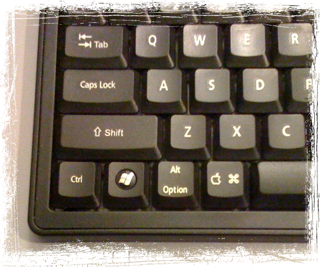The classic example of a business SaaS is Salesforce.com, widely used for the important task of tracking the people with whom you do business. You don't install the Salesforce software on your computer you connect with it through a web browser. The same is true of Google Docs. This is software that lets you do word processing and create spreadsheets and presentations, but it "lives" on Google computers, not your computer.
In fact, blogs like this one are also SaaS. The software that lets me edit and present this blog post is on a Google computer and I operate that computer via a web browser. Even Facebook and Twitter can be considered examples of SaaS, particularly when it comes to trashing your work. What do I mean by that? Here's a scenario to which many can relate:
You spend time crafting a paragraph of words that are being typed into a text box in a web browser. You then click Save or Send or Submit or Update, whatever the button is called for that particular page. And nothing happens, or something happens but it's not good, the page reloads and your carefully crafted paragraph of words has disappeared. Sometimes there is an error displayed, like "Server Error" or "Authentication Failed" or the polite but infuriating: "Sorry, we cannot complete your request at this time." The point is, polite as the site might be, it has lost your work.
 So how do you recover from this? I make it a habit to use two keystrokes right before I click Save. These keystrokes are: Ctrl-A and Ctrl-C in Windows; Apple-A and Apple-C on a Mac. These two keystrokes select All the contents of the text entry box and Copy them to the Clipboard, that slice of computer memory you use to copy things from one place to another. Then, if the SaaS that I am using somehow loses the contents that I just asked it to Save, I still have them, preserved in the Clipboard.
So how do you recover from this? I make it a habit to use two keystrokes right before I click Save. These keystrokes are: Ctrl-A and Ctrl-C in Windows; Apple-A and Apple-C on a Mac. These two keystrokes select All the contents of the text entry box and Copy them to the Clipboard, that slice of computer memory you use to copy things from one place to another. Then, if the SaaS that I am using somehow loses the contents that I just asked it to Save, I still have them, preserved in the Clipboard.I have a second, more advanced strategy for serious work with a SaaS. If I am editing a particularly long piece of text, maybe a major blog post, I use Ctrl-A followed by Ctrl-C, as above, then I switch to an open document file that is local--for example Notepad or TextMate or even OpenOffice Writer--and press Ctrl-V. That pastes the contents of the Clipboard into a document that is independent of the web browser. If the SaaS crashes I still have my work. I could take that a step further and press Ctrl-S for Save after pasting into the document. That enables the work to survive a computer crash, should the SaaS behave really badly.
The whole process can be carried out very quickly, particularly if you are comfortable with the Tab commands for switching applications. So on a Windows machine where you have Firefox and OpenOffice Writer running it would go like this:
Ctrl-A, Ctrl-C while editing the SaaS text box in Firefox
Alt-Tab to switch to OpenOffice
Ctrl-V and Ctrl-S to paste the text and save it.
Alt-Tab to return to the SaaS in Firefox
Execute Save/Submit command in the SaaS
If you are using a Mac the sequence is the same but the keys are even easier:
Apple-A, Apple-C while editing the SaaS text box in Firefox
Apple-Tab to switch to OpenOffice
Apple-V and Apple-S to paste the text and save it.
Apple-Tab to return to the SaaS in Firefox
Execute Save/Submit command in the SaaS
Having lost more typing than I care to remember due to browser-based applications failing to save as instructed, these preventative keystrokes are second nature to me. When the work is a series of paragraphs I may save to the clipboard as I go. BTW, as an added bonus, saving to a local document file is a handy way to keep a record of your work (for example, I write a lot of comments on blog posts and some blogs just seem to lose them or fail to approve them, casting my well-chosen words into the ether, but I have a record of them in my local files).
The risks to your SaaS are not all equal. Some applications that involve extensive text entry perform periodic auto-saving (in the case of Google Docs I find the auto-save is actually too frequent). And a lot of work in programs like Salesforce consists of small pieces of data entered in a series of fields or indicated by radio buttons or checkboxes. These tend to be saved more reliably. It is in places like a "Comments" or "Notes" section that you can spend a lot of time getting your words right only to find you have to write them all over again (unless you used the preventative keystrokes described above).

No comments:
Post a Comment